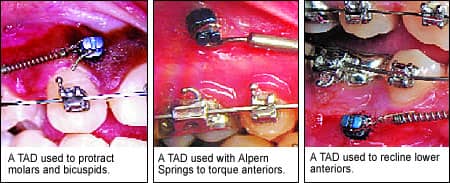by Jack C. Fisher, DMD

The purpose of this article is to address the question of anesthesia when placing TADs. Is it necessary to use injected anesthesia, or can the clinician simply use some of the new stronger topical anesthetics that are offered?
Topical or Injected?
The first question that should be asked is: Why would one want to use only topical anesthesia when placing TADs? There is no question that local injected anesthesia gives a more profound and consistent result than just the use of topical anesthesia. In many cases, topical anesthesia is all that is necessary. A problem arises, though, when it is not effective enough to completely seat a TAD. The goal is to place the TAD in a patient without the patient feeling any discomfort.

TADs placed between teeth often cause a significant amount of discomfort. When placing a self-drilling, self-tapping anchor, you need to have a good understanding of what is actually taking place in the bone of the patient. Self-drilling anchors do not remove bone, as drilling a hole prior to insertion does. They are actually compressing the bone. This will often compress the periodontal ligaments of the adjacent teeth, causing the patient undue discomfort. It is true that bone has very few sensory nerve endings. However, the periodontal ligaments (PDL) of the adjacent teeth are highly innervated. Topical anesthetic will, in most instances, anesthetize the mucosal tissues sufficiently that the orthodontist will be able to penetrate the tissue with the anchor without hurting the patient. On the other hand, it is unlikely that the topical will anesthetize the PDL of the teeth adjacent to the anchor.
Other Choices to Make
TADs placed in the zygomatic process of the maxillary bone should be 2 mm in diameter, as compared to the smaller-diameter TADs that are placed between the roots of teeth. It has been my experience that the larger diameters of anchors cause enough compression of bone that the patient often feels some discomfort if only topical anesthesia is used. This also applies to anchors placed in the palate.
It is my opinion that, when placing TADs in D1 bone found in the mandible, that a pilot hole should be drilled through the depth of the cortical bone prior to insertion. I would certainly advocate local infiltration of anesthesia prior to performing this type of procedure.
If the new topical anesthetics are profound enough to prevent the patient from feeling the penetration of a TAD, then the patient certainly would not feel the penetration of a needle to administer a small, local injection of anesthesia needed to anesthetize only the tissues surrounding the roots of the teeth. Note: Do not anesthetize the teeth, anesthetize only the bone in which the anchor will be placed.
With adequate, recurrent training, orthodontists will certainly feel confident in administering proper anesthesia prior to the placement of TADs.










